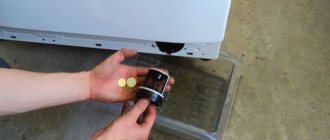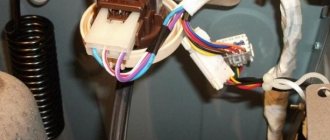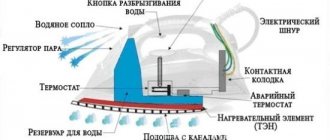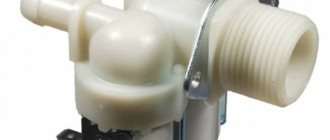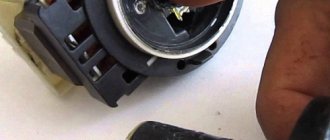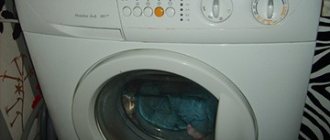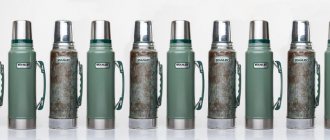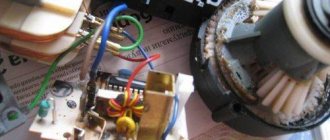This article will be useful to those who want to repair a clothes steamer with their own hands. Unfortunately, no one is immune from the fact that equipment may fail. But if there is an appropriate tool in the house, and the owner has basic knowledge of electrics, restoring functionality will not be difficult.
Household floor steamer for clothes in operation
What is a clothes steamer?
Before repairing any device, it is necessary to study its structure and operating principle, otherwise you will have to call a technician or take the product to a service center. What is a steamer?
Components of a modern clothes steamer
A steamer (hereinafter also referred to as a steamer, from the English word steam, which means “steam”) is intended for treating fabrics with steam. This smoothing method has many advantages over using a steam iron. The steamer allows you to process areas of clothing that are difficult or impossible to straighten with a simple iron. This primarily applies to small folds in the area of buttons, on sleeves, and near seams. When steaming, there is no mechanical impact on the fabric, which is especially important for delicate materials.
The steamer smoothes fabrics much more effectively than any iron.
Clothes steamers have other advantages:
- when treated with steam having a temperature of about +100 ℃, the clothes are disinfected;
- effectively smooths out any fabrics, removes creases and small folds in the most inaccessible places;
- some types of stains are removed;
- fibers do not deform under the influence of steam;
- during steam treatment, foreign odors of perfume, tobacco, sweat and others are eliminated;
- clothes with embroidered elements, as well as those decorated with beads and other decorative elements are not damaged;
- lace products and items of complex cut are smoothed well;
- an ironing board is not required to iron clothes;
- The steamer is ready to work within 40 seconds after switching on.
Steamer device
Today, two types of steamers are produced: stationary floor-mounted and hand-held, which are light in weight and small in size. Compact hand-held steamers are good to take with you on the road; they will be useful when traveling. There are devices on sale from various manufacturers: Philips, Maxwell, MIE, Kitfort, Karcher and others.
A handheld clothing steamer also doubles as a steam cleaner.
The devices consist of several main components:
- a reservoir into which water is poured;
- boiler;
- electrical unit;
- pump with pressure piston;
- sprinkler
The water is heated in a boiler, where it enters through narrow tubes from the tank. Heating and conversion of water into steam is carried out by a tubular electric heating element (hereinafter also referred to as heating element), controlled by a thermostat. The temperature inside the boiler reaches 120–130 degrees Celsius, so it is no wonder that scale forms in steamers, as in irons, over time, interfering with their functioning.
Design and location of controls in the Kitfort KT-915 Professional Series steamer
Steam is forced into the atomizer by a piston and pump, which create the required level of pressure (when the pressure becomes too high, the safety valve is activated). The steamer is controlled by an electrical unit, the circuit diagram of which includes a thermal fuse. It is triggered when the temperature in the boiler exceeds the permissible limit (+160…170 ℃).
Device
Garment steamers are made to process garments using steam. The second name for such a unit is steamer. A steamer works in the same way as an iron - it can be used to smooth out creases and folds on clothes using water steam. Thanks to such a device, you can easily solve some problems that are beyond the power of an iron. For example, smooth out small wrinkles under a button, sleeve, near seams. Some models are equipped with a special iron, which can be used to smooth out hard-to-reach wrinkles. In this case, mechanical action is used together with steam.
Previously, steamers were used only in ateliers and garment factories. The devices were large in size and had a high price tag.
Currently, manufacturers offer different models of steamers, which are divided into two categories:
At home you can usually find the second option. Its design is similar to a coffee machine. The steamer circuit contains the following parts:
- boiler;
- water storage container;
- electrical system;
- a piston equipped with a pump;
- spray.
The boiler is the main part. It contains a heating element, a thermostat with a safety valve. The liquid from the reservoir moves through special tubes and, when heated, is converted into steam. The steam is then directed to the atomizer, where a piston and pump create the required level of pressure for atomization. All actions are carried out using electricity, so without fuses and wires, the steamer cannot operate.
Overview of main faults and ways to resolve them
There are not many common damages to steamers. The most common malfunctions encountered are:
- the water in the boiler does not heat up at all or heats up poorly;
- steam does not form and does not escape through the sprayer;
- the device does not steam due to poor steam generation;
- steam comes out in places where it shouldn't appear.
Before starting repair work, you should carefully read the technical documentation; without this, it is unlikely that you will be able to repair the device. It also happens that the necessary information has to be collected bit by bit. This especially applies to products made in China.
Repair of steamers in the service center
Necessary tool
To diagnose and repair the electrical part of the steamer, you can use a multimeter (hereinafter also referred to as a tester). Typically, such a device is in the arsenal of owners who like to make and repair everything with their own hands.
In addition, you may need the following tools and materials:
- sets of flat and Phillips screwdrivers;
- pliers and platypuses;
- knife;
- soldering iron;
- electrical tape and heat shrink insulating tubing.
A set of tools that should always be at hand
Not all of the above may be needed, but it is necessary that these tools and materials are available.
Atomizer does not produce steam
This damage is one of the most common. There may be several reasons for this:
- scale has closed the steam channels in the boiler or sprayer;
- The pump that drives the piston to supply steam does not work.
If there is a blockage, the steamer must be cleaned, and this can be done mechanically or chemically.
Mechanical cleaning
For mechanical cleaning, the device body will have to be disassembled. There may be certain difficulties here, because some manufacturers (for example, Philips) fix the case with screws with an original head. This can be a TORX (six-pointed star); there are also caps with a three-pointed star. In such cases, you can try to unscrew the screws with a simple flat-head screwdriver, selecting it according to size.
Screw head made for TORX slot
Next, you should disconnect the electrical wiring from the water supply system. To avoid mixing up anything during assembly and leaving behind “extra” parts, document the work process by taking photographs. When disassembling, do not use excessive force, as this may break the plastic latches that are often present in the case.
Disassembling the body of the floor steamer
Next, you need to remove the heating element and remove scale from its surface. This can be done with a solution of food-grade vinegar, but it is better to use a special descaler designed for irons with steam generators.
Descaler 3-in-1 descaling
If the specified drug is not on sale, you can deviate from the rules and replace it with products intended for coffee grinders, washing machines or dishwashers, the effect will be the same. Also wash the inside of the boiler and the flask intended for water.
Chemical cleaning
This method is used without disassembling the case. Fill the water tank with a solution of table vinegar (in a 1:1 ratio). Turn on the steamer and let it release steam until the solution in the flask runs out. This will clean all the parts that may clearly show signs of scale formation: heating elements, steam-generating tubes, steam holes in the atomizer.
Pouring vinegar solution into the tank to descale the steamer
Pump malfunction
In this case, repairs will also require complete disassembly of the steamer. Then use a multimeter to check the presence of 220 V mains voltage at the terminals inside the housing. If voltage is present, remove the plug from the outlet. Now disconnect the terminals going to the pump, which is connected in parallel to the heating element.
Location of the pump in the disassembled steamer body
These wire terminals supply voltage to the pump motor. To check the integrity of the motor windings, test the circuit with a multimeter. An open circuit or very high resistance will mean that the windings have burned out. A replacement pump can be ordered from the service center. If problems arise with the purchase, you can solve the problem by rewinding the motor yourself, selecting a wire of the appropriate cross-section (if you already have such experience).
Removing the inlet valve in the steamer
When the pump is working properly, there may be no steam formation due to the fact that the water supply valve, which is located at the inlet to the boiler, is faulty. It looks similar to the nipple on a bicycle inner tube, so you can easily spot it. The part is cleaned with a solution of citric or acetic acid, but for this it must first be removed.
By watching the proposed video, readers can get acquainted with how a non-standard repair of the Grand Master GM-Q7 Multi steamer, in which there is no steam generation, is carried out:
Steam doesn't just come out of the atomizer
In this case, we will talk about the fact that steam begins to “flow” through microcracks formed in the hose. They are difficult to see with the naked eye, but over time they will expand. This defect is accompanied by a drop in the pressure of the steam flow leaving the atomizer.
New hose for steamer
This defect can be eliminated by replacing the hose. Attempts to seal cracks, as a rule, lead to nothing, since during operation the hose is constantly subject to bending and twisting stress.
No water heating
Three parts may be to blame for this malfunction: the heating element, the thermostat and the thermal fuse. For repairs, which consist of diagnosing and replacing the above parts, you will also have to disassemble the steamer body.
Diagnostics is carried out with a multimeter. A working heating element has a relatively low resistance, which fluctuates in the range of 20–60 Ohms, and if there is a malfunction, the tester will show an open circuit. The same applies to the fuse - in good condition, its resistance approaches zero, and if the part is burned out, the multimeter will indicate an open circuit. The thermal fuse is easy to locate; it is usually attached to the boiler body with a bracket.
Some models of steamers have two thermostats, one of which controls the pump, the other controls the heating element.
The thermostat is also easy to find, it is shaped like a tablet (see photo). The part is a relay whose operation is based on the properties of a bimetallic plate. At low temperatures in the thermostat that controls the heating element, the relay contacts are closed, that is, the tester will show a short circuit during diagnostics. As soon as the temperature in the boiler reaches a certain level, the relay should open the circuit.
When diagnosing the thermostat that controls the pump with a multimeter, the picture will be the opposite. It should signal an open circuit at low temperatures, and when heated, the contacts will close. If one of the thermostats is faulty, a new part will have to be ordered from a service center.
Do-it-yourself repair of clothing steamers: troubleshooting methods
In modern everyday life, a steamer is constantly used. Incorrect operation, manufacturing defects, or mechanical damage to internal parts may result in equipment failure. If a breakdown is detected, repairs of clothing steamers are required.
Description and purpose of the device
A steamer is a convenient device for home use, designed to smooth clothes by producing dry or wet steam. Using the device, it is possible to reduce the time spent on processing textiles and upholstered furniture.
Design and operating principle
The operating principle of the device is based on the production of steam from water poured inside thanks to a heating element. It is this element that is most often subject to breakdowns. If there is no liquid in the tank, the heating element should turn off automatically, but in the event of a failure, it burns out and the device fails.
All types of steamers have a similar design and practically do not differ in external features. The main part of the devices is the housing, which houses the steam generation system. A fluid reservoir is attached to the body. The devices are also equipped with a steam hose with an iron, inside which steam moves. An additional element is a stand where there is a mount for a steam iron and clothes hangers. The type of racks may differ in different models of steamers.
Basic Troubleshooting Methods
The procedure for repairing a device depends on the specific type of failure. Before you begin repairing the steamer, you need to conduct a comprehensive diagnosis and understand the characteristics of the malfunction. It is also worth studying in advance information about the most typical equipment breakdowns.
Mechanical cleaning
For mechanical cleaning, you will need to disassemble the device. Due to its simple design, a regular screwdriver will be enough. The steamer is disassembled in the following way:
- Disconnect the electrical wiring and fluid supply system.
- Remove the tubular electric heater and clean off the scale.
- Rinse the tank with a solution of water and food vinegar. You can also use a specialized anti-scale solution created for steamers.
When disassembling the case, it is recommended to draw a schematic drawing or take photographs of each step. This will help to properly assemble the device after descaling, without leaving any unnecessary parts.
Chemical method
The advantage of the chemical method is that you do not need to disassemble or even disconnect the device from the network. To get rid of the accumulated scale, the tank is filled with a mixture of water and vinegar essence with a concentration of 3%, maintaining equal proportions. Then the device is turned on and the solution is heated until steam forms, waiting until the liquid has completely evaporated. As a result, not only the heating element will be cleaned, but also the openings of the atomizer and tube, which are also often covered with scale.
If the built-in heating element, atomizer and conductive tubes are not covered with scale, and the device still does not release steam, you will need to contact a specialist.
It is recommended to use the services of the service center of the company that produced the steamer.
Pump repair or replacement
A common reason why steam does not flow and the device requires repair is a broken pump. In this situation, it is easier to use professional help, but situations may arise when you have to do the repairs yourself. Opening the case is not difficult, but it will be necessary to turn it on in a disassembled state, which can lead to dangerous consequences.
To disassemble the structure, you must take precautions and follow step-by-step instructions. Since the pump is installed parallel to the heating element, the following steps are performed for repair:
- open the case;
- connect the device to the network;
- check the voltage at the pump contacts so that it corresponds to the value specified in the attached technical documentation;
- if the contacts are working properly and voltage is present, pull out the plug from the socket;
- Using a tester, all elements of the pump are called and, if there is no signal, new windings are wound onto the motor or replacement is carried out.
Steam leakage
As a result of using the steamer too intensively, defects may appear on the hose. Even small cracks are enough for steam to escape through them, and not through the spray. When faced with a problem, you should immediately begin repairs, since the holes in the hose will gradually increase in size.
The optimal solution to the problem is to replace the hose. You can replace it yourself or contact a service center. It is important not to try to tape or tape the holes. Electrical tape and adhesive tape are unable to withstand the effects of heated steam, so this method of repair will only take time and will not bring results.
Water heating problem
If the water does not heat up when you turn on the device, there may be several reasons for the problem, and all of them are related to the components of the boiler. As a rule, heating does not occur due to a breakdown of the heating element, thermostat and thermal fuse. If this problem occurs, you will not be able to use the steamer for its intended purpose, since it will not convert the poured liquid into steam.
heating element
To figure out if the heater is not functioning due to scale formation or is completely burnt out, you need to disassemble the device. Dismantling is carried out in the same way as is required to clean the heating element. For diagnostic purposes, the heater is called a tester. If a breakdown is detected, repair will be impractical, so it is recommended to replace the faulty part or the entire device.
Thermal fuse
The fuse is attached to the broiler body using a special bracket. Most often, the water in the device does not heat up precisely because the thermal fuse is broken. To diagnose and repair the element, you need to disconnect the device from the power supply and ring the wire on both sides. If there is no signal when the tester makes a call, it means the fuse has blown.
How to eliminate mechanical damage
Minor chips and cracks on the body of the device may not affect its functioning, but serious mechanical damage leads to problems in everyday use. It is almost impossible to eliminate large defects on the case, so it is better to replace the damaged element.
In what cases should you contact specialists?
It is recommended to use the help of service center employees in situations where you cannot independently find out the causes of the malfunction or when you doubt the effectiveness of the repair. In addition, repairs may require the use of specialized equipment. The advantages of contacting a service center from the manufacturer include:
- availability in the service of parts necessary for repairing a specific type of steamer;
- fast comprehensive diagnostics, which allows you to determine the exact cause of the breakdown;
- repairs by professional employees with a quality guarantee.
Why use clean water
The cause of most steamer problems is scale, so it is important to try to prevent its occurrence. An effective way is to properly prepare the liquid. The best option is to use distilled water, which can be purchased at auto stores and pharmacies.
Since purchasing distilled water frequently is expensive, you can prepare your own water using a kettle, a water filter, and a heat-resistant container.
The importance of using clean water
One of the most common failures of steamers is the formation of scale in the boiler, steam pipes and nozzle holes. To avoid unnecessary repairs, use only distilled water. If you have difficulty acquiring it, you can prepare a clean liquid yourself.
If you use tap water for the steamer, the device will quickly fail
To prepare, use a kettle, any clean glass container and a water filter. Boil water in a kettle and pour it into a glass container to cool and settle. After a few hours, pass the settled water through the filter. This liquid will form much less scale than regular tap water.
You should avoid using bottled water, even if the label says it can be used in irons. In fact, there are no less salts in such water than in tap water, and it will also create scale in the boiler.
To summarize, I would like to note that with certain skills, repairing a clothing steamer can be done with your own hands.
To avoid breakdowns
Some parts of the steamer may age, this is typical for almost all devices. However, scale is the cause of many problems, and it is very important to try to avoid it. How? One way is proper water preparation.
Important! In general, for such devices it is best to use distilled water, which can be purchased at automobile stores and pharmacies. True, this pleasure is expensive.
The distillate can also be prepared at home. For this you will need:
- kettle;
- heat-resistant container;
- water filter.
The process won't take too long.
- Pour water into the kettle.
- Bring to a boil.
- Pour the water into a heat-resistant container.
- Let it sit.
- Filter the precipitate.
Important! To filter water, it is best to use a vessel with a carbon cartridge.
Should you use bottled water?
On sale you can find bottled water labeled “for irons.” It seems that a solution has been found; the manufacturers have taken care in advance to ensure that your steamer lives happily ever after. However, everything is not quite like that:
- Practice shows that when using such water, no less scale is formed than from ordinary tap water, and the difference in price is considerable.
- In addition, flavorings are often added to bottled water for ironing, which is not always good for clothes.
Important! As for bottled drinking water, it should absolutely not be poured into steam devices. It is quite often supplemented with mineral additives, which are beneficial for humans, but detrimental to the steam generator.
